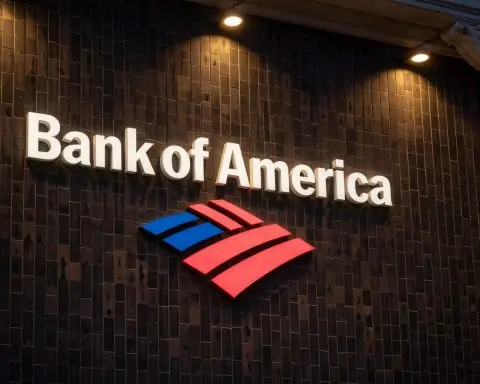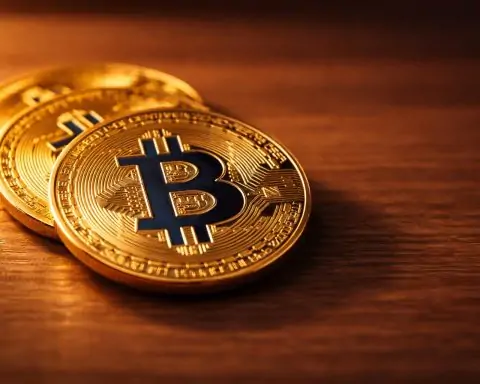- Powell’s Jackson Hole speech signaled possible rate cuts, sending Bitcoin about 3.5% higher to over $116,000 and Ether up roughly 12%, with total crypto market cap above $4 trillion.
- Bitcoin broke above $117,300, triggering roughly $380 million in bearish short liquidations in a single day.
- Ethereum surged past $4,870 to a new all-time high, aided by renewed institutional inflows and Aug 21 ETH ETFs adding $287.6 million to push total ETH ETF assets above $12.1 billion.
- Solana (SOL) rose about 10% to around $206, as traders target $250–$260 and await ETF clarity.
- Ripple’s XRP traded above $3 as ETF optimism grows, with traders watching $3.10 for a potential break toward $4.
- Dogecoin climbed about 9% to roughly $0.237, with on-chain data showing large holders scooping up over 680 million DOGE in August.
- Chainlink (LINK) jumped about 12% to a fresh 2025 high near $26 after announcing a token buyback program.
- Lido DAO (LDO) and Ethena (ENA) rose 14–15% as the SEC ruled liquid staking is not a security, with ENA volume at $1 billion in 24 hours and Lido at $256 million.
- VanEck filed an S-1 with the SEC to launch a “staked Solana” ETF holding JitoSOL, signaling TradFi access to Solana staking yields.
- Coinbase’s Ethereum L2 Base reportedly crossed $200 million in TVL, with daily transactions rivaling other major rollups.
Crypto markets went into overdrive over the past 48 hours as bullish news and dovish signals converged. From surging prices (with Ethereum smashing its all-time high) to major blockchain updates, DeFi and NFT revivals, and regulatory shake-ups across the globe, the blockchain sector saw a whirlwind of developments on August 22–23, 2025. Below is a comprehensive roundup of the biggest stories, with key sources and figures cited.
Crypto Markets Surge on Fed’s Dovish Signal
A broad crypto rally unfolded after U.S. Federal Reserve Chair Jerome Powell struck a surprisingly dovish tone in his Jackson Hole speech. Powell hinted at possible interest rate cuts, saying “downside risks to employment are rising” and suggesting policy might soon ease [1]. The prospect of cheaper money sent risk assets soaring – the Dow Jones jumped ~2% and crypto’s total market cap climbed back above $4 trillion [2]. Bitcoin spiked ~3.5% to over $116,000, while Ether surged ~12% on the day, teasing a break of its November 2021 all-time high [3]. Altcoins outpaced Bitcoin, with Dogecoin and Solana leading gains amid “increasingly bullish” momentum [4]. Powell’s rate-cut signal effectively flipped global markets into risk-on mode, igniting crypto after weeks of consolidation [5].
Bitcoin Breaks Above $117K, Eyes New Highs
Bitcoin (BTC) enjoyed a significant breakout, rallying to about $117,300 – a multi-month high. This move liquidated nearly $380 million in bearish short positions in a single day [6]. In total, about $629 million in crypto futures were wiped out across 150,000+ traders as Bitcoin and Ether spiked higher [7]. Analysts are increasingly optimistic that new all-time highs may be on the horizon. Some suggested the crypto “uptrend is back”, with BTC price targets of $145,000 in 2025 and even $200,000 by year-end now entering the conversation [8]. The bullish sentiment is buoyed by expectations of policy changes (such as more crypto-friendly retirement account rules) and the general return of risk appetite. Looking further ahead, major investors are doubling down on Bitcoin’s long-term potential – for instance, Bitwise Asset Management now forecasts BTC could reach $1.3 million by 2035, citing fixed supply and growing institutional demand as key drivers [9]. For now, Bitcoin sits just shy of its all-time high (~$120K), with this week’s Fed-fueled surge “opening the door to fresh all-time highs,” as Cointelegraph noted [10].
Ethereum Blasts to New All-Time High
The market’s spotlight turned to Ethereum (ETH), which shattered its record price. Ether surged past $4,870, definitively topping its previous peak from November 2021 [11]. This ~250% rebound from April’s lows came on the back of Powell’s dovish remarks – looser monetary policy historically favors risk assets like ETH [12]. Additionally, renewed institutional inflows into Ethereum investment vehicles turbocharged the rally. On August 21 alone, U.S.-based Ether ETFs saw $287.6 million of inflows, bringing total ETH ETF assets to over $12.1 billion [13]. Corporate treasuries are also buying in: companies acquired roughly $1.6 billion worth of ETH in the past month as part of treasury diversification [14]. With demand outstripping supply, some analysts now predict Ether could reach $10K–$13K in coming months [15]. The surge in ETH has slightly diluted Bitcoin’s dominance (BTC’s share of crypto market cap fell below 60% for the first time in four months), as capital rotates into altcoins [16]. Ethereum’s network fundamentals remain strong as well, with rising activity and renewed Ether ETF optimism underpinning its climb [17]. All told, Ethereum’s record-breaking run this week underscores its pivotal role in the crypto ecosystem’s growth.
Altcoins & DeFi See Renewed Momentum
It wasn’t just the big two cryptocurrencies enjoying the rally – altcoins and DeFi tokens also notched notable gains and milestones:
- Solana (SOL): The high-performance Layer-1 jumped about 10% to ~$206, riding the broader market wave [18]. Traders are eyeing $250–$260 as a next target if SOL can maintain momentum – especially with potential ETF clarity on the horizon (more on that below) [19]. An unexpected boost came from pop culture as well: rapper Kanye West reportedly launched a meme token (“YZY”) on Solana this week, which briefly hit a $3B market cap before cooling to $1.5B, stress-testing Solana’s network capacity [20].
- XRP: Ripple’s token rebounded above $3 amid the market upswing, and technical analysts are watching the $3.10 level as a break above that could open a path toward $4 [21]. Institutional adoption news and optimism about an XRP ETF (see Regulatory section) have bolstered sentiment, even as some whales took profits. Despite recent selling by large holders, ETF excitement and use-case traction have many analysts arguing XRP’s “structural flows” remain positive if it can clear resistance [22].
- Dogecoin (DOGE): The memecoin king roared back to life, rallying ~9% to ~$0.237 in 24 hours [23]. Dogecoin significantly outperformed Bitcoin’s gains, buoyed by both the general risk-on mood and some whale accumulation. On-chain data shows that large holders scooped up over 680 million DOGE (worth ~$157M) in August, a sign of confidence that helped propel the “meme-king” upward [24]. Technical indicators for DOGE suggest there’s room for further upside – its RSI is only ~55 (not yet overbought) and a recent “golden cross” formed on moving averages, indicating bullish momentum [25] [26].
- Chainlink (LINK): Oracle token LINK jumped about 12% to a new high for 2025 amid the rally [27]. The surge followed Chainlink’s announcement of a token buyback program, which combined with the market’s upswing to push LINK to levels unseen this year. At ~$26, LINK’s strong move reflects both improving sentiment for oracle networks and specific institutional buying interest noted by analysts [28].
- DeFi Staking Tokens (LDO & ENA): In decentralized finance, liquid staking projects were big winners. Lido DAO (LDO) and Ethena (ENA) – both tied to Ethereum staking – leapt 14–15% on Friday, erasing last week’s dip as traders aggressively bought the earlier pullback [29] [30]. Notably, these rallies came after a favorable regulatory signal: the U.S. SEC recently clarified that liquid staking protocols are not securities, a view that triggered bullish sentiment and fresh institutional interest in the staking sector [31]. Trading volumes for ENA doubled to $1B in 24 hours and Lido’s volume jumped 83% to $256M [32], highlighting renewed demand. Observers caution that Ethereum’s hefty validator withdrawal queue (over 825k ETH, ~$3.8B) still looms as potential sell pressure if unstaked, but so far the DeFi staking boom appears to have legs [33]. Institutional players are already stepping in; for example, Figment has emerged as a dominant staking provider, indicating that “institutional inflows were beginning to drive the sector.” [34].
Overall, the altcoin resurgence – from majors like SOL and XRP to DeFi tokens and meme coins – signals a broad return of investor risk appetite. Traders are rotating into higher-beta plays as ETH and BTC hold key levels, a dynamic often seen in crypto bull runs [35].
Web3 Infrastructure & Scaling Updates
Alongside price action, there were notable developments in blockchain infrastructure, Layer-1/Layer-2 scaling, and bridging between crypto and traditional finance:
- Solana Staking ETF Filing: Traditional finance is making new inroads into crypto yields. Asset manager VanEck filed an S-1 with the SEC to launch a “staked Solana” ETF – a fund that would hold JitoSOL (a liquid-staked SOL token) to give investors exposure to Solana staking rewards [36]. This first-of-its-kind ETF aims to bring blockchain-native yield into TradFi rails [37]. The SEC has reportedly been in talks with ETF issuers like VanEck about integrating staking returns into funds [38]. VanEck isn’t alone, either – Fidelity, Grayscale, and Franklin Templeton are also eyeing Solana staking funds, underscoring a “continued interest” in on-chain yield products from major institutions [39]. If approved, these ETFs could broaden access to crypto staking for mainstream investors, potentially unlocking new capital for PoS ecosystems.
- Axie’s Ronin Migrating to Arbitrum: A noteworthy Layer-2 adoption move came from the gaming realm. Sky Mavis, creator of the popular play-to-earn game Axie Infinity, proposed migrating its Ronin sidechain to Arbitrum’s “Orbit” framework – effectively turning Ronin into an Ethereum Layer-2 [40]. Under the plan, the RON token would remain the gas currency and Arbitrum would provide the security and scalability benefits of Ethereum for Axie’s ecosystem [41]. Ronin has around 1.8 million daily users, so this is a significant win for Arbitrum and L2s in general, expanding their reach into gaming [42]. The migration (targeted for completion by 2026) is seen as “bullish for Arbitrum – capturing a top gaming chain would broaden DeFi/NFT use cases and cement Arbitrum’s lead in modular L2 solutions.” [43] It also reflects a broader trend of app-specific chains seeking the security of Ethereum’s L2 ecosystem.
- Cross-Chain Bridges: Interoperability got a boost as well. 1inch Network this week launched native cross-chain swaps between Solana and EVM chains (Ethereum, BSC, etc.), simplifying liquidity flows between Solana’s ecosystem and the wider DeFi world (source: The Block, Aug. 21). Likewise, the Sei Network – a new trading-focused L1 – announced reaching 8.3 million wallets (second only to Coinbase’s Base L2 in 2025 growth), highlighting the proliferation of emerging chains (source: AInvest, Aug. 22). And speaking of Base, Coinbase’s Ethereum L2 reportedly crossed $200M TVL as of this week, with daily transactions rivaling other major rollups (community data). All these indicate that multi-chain activity and Layer-2 scaling are accelerating, with major projects and new entrants alike expanding Web3’s infrastructure.
NFT and Metaverse Developments
After a quiet summer, the NFT and metaverse arenas saw signs of life as well:
- NFT Market Revival: NFT traders are coming back, lured by lower prices and the broader crypto rebound. The floor prices of top collections have been climbing – for example, the iconic CryptoPunks saw its floor jump ~15–16% recently (from ~41 ETH to around 47 ETH) amid renewed demand [44]. July’s data showed a significant uptick in NFT activity: monthly NFT sales volume hit $574 million in July, up nearly 48% from June and the second-highest month of 2025 [45]. While total transaction counts were slightly down, the average NFT sale value spiked to ~$113, a six-month high [46]. This suggests buyers are focusing on higher-value blue chips, consolidating their bets. Notably, Ethereum-based collections dominated – all of the top 10 NFT collections by market cap are on Ethereum, and ETH NFT market cap grew 21% in late July to over $8B [47]. Collections like Pudgy Penguins outperformed even CryptoPunks with a 65% floor price rise in July, hinting at possible sector rotation within NFTs [48]. In short, the NFT market is showing flickers of a comeback, aided by the crypto price rally and perhaps a rotation into digital collectibles as an alternative bet.
- Metaverse Gaming – Wilder World’s Big Debut: In the metaverse gaming space, Wilder World made headlines at Gamescom 2025. The project launched a first-person shooter (FPS) mode in its immersive metaverse, marking a new expansion of its virtual world “Wiami” [49]. To celebrate, Wilder World is hosting a $100,000 global esports tournament, with a live finale and travel rewards for top players [50]. Notably, Samsung partnered with Wilder World for this debut, with attendees at Gamescom (Aug. 23–27 in Cologne) able to play the FPS early and even claim a Samsung-branded NFT badge (POAP) for participating [51] [52]. “The $100K tournament isn’t just about esports, it’s a global stage to show the world that Wilder World is building at the frontier of gaming and the metaverse,” said the project’s co-founder known as n3o, adding that “partnering with Samsung at Gamescom solidifies our belief that Web3 gaming will be mainstream in the next wave of entertainment.” [53]. Beyond the FPS launch, Wilder World touted other recent milestones – it sold out a Lamborghini-themed NFT car collection in 4 minutes, initiated a multi-million dollar token buyback, and has consistently ranked in the Top 10 Most Anticipated Games on Epic Games Store [54] [55]. The takeaway: metaverse gaming continues to mature, blending with traditional gaming events and attracting big-name partners, even as broader NFT land sales and virtual real estate remain subdued.
Regulatory & Legal Roundup
Regulators and lawmakers across major jurisdictions were busy with crypto-related actions and proposals in the past two days, spanning everything from ETF filings to tax reforms:
- U.S. – Wave of Spot XRP ETF Filings: In the wake of Ripple’s partial courtroom victory earlier this year, at least seven asset managers (including Grayscale, Bitwise, CoinShares, WisdomTree, Franklin, 21Shares, and Canary) have now filed updated proposals for spot XRP exchange-traded funds [56]. On Aug. 22 they submitted amended S-1 filings that adjust the fund structures to allow XRP-based “in-kind” creations/redemptions (not just cash), apparently to address SEC feedback [57]. Analysts called this cluster of filings a “very good sign,” interpreting it as fund issuers actively working with the SEC’s comments [58] [59]. While approval is not guaranteed, the responsiveness suggests a spot XRP ETF approval is being seriously contemplated. Notably, BlackRock – which leads the pack on Bitcoin and Ether ETFs – has not filed for XRP and says it has no plans to, so this push is coming from other players [60]. The price of XRP jumped ~7% to around $3.08 on Friday amid the optimism [61]. If any of these ETFs get the green light, it would mark the first U.S. spot XRP fund and a further legitimization of crypto assets on Wall Street.
- U.S. – IRS Crypto Chief Resigns: The IRS’s head of digital assets, Trish Turner, abruptly resigned after just three months in the role [62]. A 20-year IRS veteran, Turner announced she is departing for the private sector – specifically joining a crypto tax advisory firm (Crypto Tax Girl) as Tax Director [63] [64]. In a LinkedIn post, Turner lauded the progress made in standing up the IRS’s crypto compliance strategy but said she hopes to help “bridge the gap between industry and regulators” from outside [65]. Her exit follows the departures of two prior IRS crypto project leads (Raj Mukherjee and Seth Wilks) earlier this year, who each lasted about a year [66]. It comes as the IRS is under mandate to ramp up crypto tax enforcement – with a wave of new tax reporting rules and possibly staff cuts looming. The timing is sensitive: the U.S. is gearing up for 2024 tax changes that will treat crypto more like traditional assets, so Turner’s departure raised some eyebrows. Observers note it leaves the IRS’s crypto division without clear leadership just as “a tidal wave of crypto tax filings” is about to hit [67].
- U.S. – CFTC’s “Crypto Sprint”: Over at the commodities regulator, Acting CFTC Chief Caroline Pham is not waiting for her new boss to be confirmed to press ahead on crypto. (President Trump has nominated Brian Quintenz as the next permanent CFTC Chair, but he’s still awaiting Senate confirmation [68].) In the interim, Commissioner Pham has kicked off another “crypto sprint” initiative, aiming to advance crypto policy and possibly new rules [69]. The CFTC is looking to update its approach on things like crypto derivatives and DeFi oversight. This echoes the agency’s prior “sprints” in 2021. Pham’s proactive stance signals that, despite leadership flux, the CFTC is keen to “get rolling on crypto” regulation [70] – particularly as Congress debates whether more authority should go to the CFTC versus the SEC.
- U.S. – Novel Anti-Cybercrime Bill: An unusual bipartisan bill has been introduced in Congress that would revive an 18th-century concept to fight modern cybercrime. The proposal seeks to authorize private citizens and companies as “21st-century privateers” empowered to go after cybercriminals (such as ransomware attackers) in exchange for bounties [71]. This harkens back to maritime privateering but applied to the digital realm. Lawmakers argue government alone can’t combat the scale of cyber threats (which often involve crypto ransoms), so legally deputizing ethical hackers or firms could help. It’s a controversial idea – effectively state-sanctioned hacking – but highlights the lengths being considered to curb cybercrime, much of which involves cryptocurrency in laundering stages.
- U.S. – Coinbase Biometric Lawsuit: In a legal win for Coinbase, a U.S. appellate court granted a stay (pause) in a lawsuit accusing Coinbase of improperly capturing biometric data [72]. The case involves Illinois’ Biometric Information Privacy Act (BIPA); plaintiffs allege Coinbase collected selfies/fingerprints for KYC without adequate consent. A lower court had allowed the suit to proceed, but now Coinbase won a brief stay pending appeal [73]. This puts the class action on hold and gives Coinbase more time – possibly indicating the appellate judges see some merit in Coinbase’s challenge. It’s a small respite in the exchange’s growing list of legal battles (which also include an SEC case), but one the crypto industry is watching as it could set precedent on how BIPA applies to exchange security practices.
- Japan – Major Crypto Policy Overhaul: In a significant development from Japan, the Financial Services Agency (FSA) unveiled plans for a large-scale revamp of crypto regulations [74]. The reform package, aimed for fiscal year 2026, includes taxation changes and new investment products. Key proposals will tax crypto profits like stock gains (a flat 20% tax) instead of treating them as miscellaneous income up to ~55% [75]. This would dramatically lower the tax burden on Japanese crypto investors and even allow carrying forward losses for 3 years to encourage market participation [76]. The FSA also plans to classify crypto as a financial product under securities law, which would legalize crypto ETFs (including spot Bitcoin ETFs) in Japan [77]. Insider trading laws and investor protection rules would be extended to crypto as well. Additionally, the agency may create a dedicated Digital Finance bureau to oversee crypto and fintech [78]. These moves are intended to integrate crypto into mainstream finance, attract institutional investment, and spur household adoption – aligning with Japan’s pro-growth agenda [79]. If implemented, Japan could become one of the most crypto-friendly developed markets (a stark contrast to its prior strict stance), potentially fueling a new wave of regulated crypto products and exchange activity in the country.
- European Union – Digital Euro on Ethereum/Solana?: In Europe, the central bank digital currency project is picking up steam. EU officials this week accelerated plans for a “digital euro” CBDC, and intriguingly, they are considering using public blockchain networks like Ethereum or Solana to issue it [80]. A report from the European Central Bank mentioned exploring Ethereum and Solana for the digital euro’s infrastructure, which would mark a bold integration of public decentralized tech for a sovereign currency [81]. This could mean the digital euro might operate, at least partly, on or interfacing with these open networks (possibly as a token on an Ethereum sidechain or Solana’s network), rather than a closed central bank system. The idea is still in evaluation, but it highlights the EU’s openness to leveraging existing blockchain ecosystems. Meanwhile, the EU’s broader MiCA regulation framework is already passed and will begin implementation in 2024, providing clearer rules for crypto firms across member states.
- Philippines – Bitcoin as “National Security” Reserve: A fascinating legislative proposal emerged in the Philippines. A Philippine congressman introduced a bill for the central bank (BSP) to acquire 10,000 Bitcoin over 5 years as part of the country’s foreign reserves [82]. The rationale: holding BTC would diversify and “protect the Philippines’ reserves amid global uncertainties,” framing Bitcoin accumulation as a national security objective. The bill, if passed, would mandate gradual BTC purchases by BSP (approximately 2,000 BTC per year). While it’s uncertain if it will gain traction, the fact that a sovereign nation’s lawmaker is formally considering Bitcoin a strategic reserve asset is notable. It echoes El Salvador’s approach (though the Philippines’ economy is far larger). This comes as Bitcoin’s stature as “digital gold” grows – even some U.S. presidential candidates have hinted at using Bitcoin in reserves. The move in Manila underscores the increasing geopolitical dimension of Bitcoin, where nations may accumulate it as a hedge.
- Other Global Moves: Elsewhere, Interpol formed a special unit to help countries track crypto crimes, India is reportedly re-evaluating its stiff crypto tax (after seeing trading volumes plummet due to a 30% tax), and Hong Kong granted more crypto exchange licenses this week as it pushes to be a Web3 hub (HashKey Exchange launched retail trading). Additionally, Preston Pysh, a well-known Bitcoin commentator, noted that early Bitcoiners remain deeply skeptical of Wall Street’s crypto embrace, worrying that institutional control might undermine Bitcoin’s decentralized ethos [83]. This sentiment reflects a cultural undercurrent even as ETFs and corporate adoption advance – a reminder that parts of the community value crypto’s independence from traditional finance.
Security & Enforcement: Hacks, Crackdowns and Resilience
The past two days brought a mix of cybersecurity developments – from law enforcement victories to opportunistic moves by hackers amidst the rally:
- Interpol’s African Cybercrime Busts: A massive international law enforcement operation struck a blow against cybercriminals. Interpol’s “OperationSerengeti 2.0” spanned 18 African countries, leading to 1,210 arrests and the seizure of nearly $100 million in assets (including cryptocurrency) [84]. The coordinated raids targeted online fraud, scams, and money laundering rings that have been proliferating across Africa. Along with the arrests, authorities confiscated luxury cars and froze thousands of bank and crypto accounts. This operation highlights increasing global cooperation in tackling crypto-related crime. It follows Interpol’s success earlier this year in a similar sweep (Operation “Jackal”) and shows that even as crypto adoption grows in Africa, so does attention to combating its illicit abuse.
- Exchange Hack – CoinDCX: In India, leading exchange CoinDCX revealed a $44 million exploit that had gone undetected for some time [85]. The CEO blamed it on a “server breach”, implying that hackers infiltrated critical systems rather than smart contract vulnerabilities. The timing is uncomfortable: it comes almost exactly one year after a $230M hack at WazirX (India’s then-largest exchange) in July 2024 [86]. CoinDCX’s hack, while smaller, rattled confidence in local exchanges. The stolen funds were reportedly drained from CoinDCX’s lending/earning service. The company has paused those services and is working with law enforcement. This incident underscores that centralized exchange security remains a point of failure. It may prompt Indian regulators to expedite tighter exchange oversight (coincidentally, CoinDCX received in-principle approval for a license just weeks ago). Users, meanwhile, are reminded of the adage: “not your keys, not your coins.”
- Hackers Cash Out During the Rally: On-chain sleuths noted that several notorious crypto hackers took advantage of Ethereum’s price surge to offload stolen funds at a profit. In fact, three high-profile exploiters collectively sold around $72 million in ETH this week into the market strength [87]. One example: the hacker from last year’s Radiant Capital DeFi exploit (suspected to be a North Korean entity) had stolen $53M in crypto and converted much of it to ~21,957 ETH at ~$2,400. This week, as ETH neared $4,800, they sold 9,631 ETH for ~$44 million in DAI, netting an extra $48.3 million on top of their original loot [88] [89]. They still hold about 12,326 ETH (over $60M) for potential future gains [90]. Similarly, the hacker of February’s Infini exploit (who stole $49.5M USDC and bought ETH) sold a portion at ~$3,762 per ETH, adding about $25 million in profit to their haul [91] [92]. Another unidentified exploiter who hacked THORChain in 2023 also dumped thousands of ETH early Friday for ~$22M, scoring a $9.7M profit versus their buy-in [93]. These maneuvers highlight how criminal actors monitor market conditions closely – big rallies provide liquidity for them to cash out without crashing prices. The unfortunate irony is that bullish events can enrich past hackers. According to Coindesk, it’s been a “brutal 18 months for crypto security” overall – over $3.1 billion was stolen in H1 2025 alone, following $1.49B in 2024 [94]. The silver lining: such movements are very traceable on-chain, and authorities (and blockchain analytics firms) are tracking the wallets. For instance, this week crypto sleuths flagged the Radiant hacker’s addresses, which could aid eventual sanctions or recovery efforts.
- Miscellaneous: In other enforcement news, U.S. authorities moved $300k of recovered Ethereum from a 2021 hack (Uranium Finance) out of cold storage, possibly preparing restitution [95]. And in a win for justice, an Israeli individual was arrested for the 2022 hack of the DeFi protocol Oyster (worth $300k) (local media, Aug 22) – showing that even years later, perpetrators can be caught. Meanwhile, white-hat hackers have been busy too: Immunefi reported that in 2025 so far, over $110M in bounties have been paid to ethical hackers who helped fix vulnerabilities before they were exploited (a strategy the crypto industry is increasingly embracing to pre-empt the black-hats).
Industry Deals and Funding
Despite the market volatility, the crypto industry saw robust investment and M&A activity through the week:
- Venture Funding: According to Messari’s latest tally, 16 crypto projects raised a combined $80 million in the week of Aug 18–22 [96]. Leading the pack were DigiFT – a Singapore-based real-world asset exchange, which secured $11M – and Irys, a decentralized data storage project, which raised $10M Series A [97]. Other notable deals included OVERTAKE (a Sui-based gaming marketplace, $7M), Legion (a fundraising platform, $5M seed led by VanEck), and LO:TECH (a London digital asset trading firm, $5M) [98]. Additionally, two firms expanded their Bitcoin treasuries: U.S.-based LM Funding America raised $23M to buy more BTC and increase mining capacity, and Dutch broker Amdax launched a Bitcoin Treasury product aiming to accumulate 1% of all BTC [99].
- Mergers & Acquisitions: Established crypto companies are making strategic acquisitions to bolster their offerings. Kraken acquired Capitalise.ai, a no-code trading automation platform, to enhance Kraken’s advanced trading tools [100] [101]. On the DeFi side, Valantis (a crypto venture firm) acquired stakedHYPE, a platform related to the $HYPE token staking, indicating consolidation in the staking/Yield-Fi space [102] [103]. And in the security realm, Kerberus (a crypto security firm) bought Pocket Universe, which is a popular browser extension that warns users of scams when interacting with Web3 sites [104] [105]. This acquisition beefs up Kerberus’s toolset for protecting users against phishing and malicious smart contracts. The flurry of deals shows that crypto firms are investing in infrastructure and safety nets, even as markets oscillate.
- Partnerships: Big partnerships also emerged. Aside from the Samsung–Wilder World tie-up mentioned above, Visa expanded its stablecoin pilot, partnering with Solana-based USDC issuer Circle to use USDC for settlement (announced Aug 23). Mastercard launched a collaboration with Binance on a crypto prepaid card in Brazil, continuing its crypto card programs. And in TradFi-meets-DeFi, Franklin Templeton joined the Stellar blockchain’s governing council and hinted at leveraging Stellar for tokenizing assets, showcasing ongoing interest by traditional asset managers in public blockchain networks.
Sources: Key insights were drawn from leading crypto news outlets including CoinDesk, Cointelegraph, Decrypt, The Block, CryptoSlate, and official project announcements on X (Twitter) and Medium. For full details and additional context, please refer to the cited sources throughout this report. [106] [107] [108] [109] [110] [111] [112] [113] [114]
References
1. decrypt.co, 2. decrypt.co, 3. decrypt.co, 4. decrypt.co, 5. decrypt.co, 6. www.todayonchain.com, 7. www.todayonchain.com, 8. www.todayonchain.com, 9. www.coindesk.com, 10. www.todayonchain.com, 11. www.todayonchain.com, 12. www.todayonchain.com, 13. www.todayonchain.com, 14. www.todayonchain.com, 15. www.todayonchain.com, 16. www.todayonchain.com, 17. www.todayonchain.com, 18. decrypt.co, 19. www.coindesk.com, 20. decrypt.co, 21. www.coindesk.com, 22. www.coindesk.com, 23. decrypt.co, 24. decrypt.co, 25. decrypt.co, 26. decrypt.co, 27. www.coindesk.com, 28. www.coindesk.com, 29. www.coindesk.com, 30. www.coindesk.com, 31. www.coindesk.com, 32. www.coindesk.com, 33. www.coindesk.com, 34. www.coindesk.com, 35. www.coindesk.com, 36. www.coindesk.com, 37. www.coindesk.com, 38. www.coindesk.com, 39. www.coindesk.com, 40. coinmarketcap.com, 41. coinmarketcap.com, 42. coinmarketcap.com, 43. coinmarketcap.com, 44. startupnews.fyi, 45. cointelegraph.com, 46. cointelegraph.com, 47. cointelegraph.com, 48. cointelegraph.com, 49. blockchainreporter.net, 50. blockchainreporter.net, 51. blockchainreporter.net, 52. blockchainreporter.net, 53. blockchainreporter.net, 54. blockchainreporter.net, 55. blockchainreporter.net, 56. www.todayonchain.com, 57. www.todayonchain.com, 58. www.todayonchain.com, 59. www.todayonchain.com, 60. www.todayonchain.com, 61. www.todayonchain.com, 62. www.todayonchain.com, 63. www.todayonchain.com, 64. www.todayonchain.com, 65. www.todayonchain.com, 66. www.todayonchain.com, 67. www.coindesk.com, 68. www.coindesk.com, 69. www.coindesk.com, 70. www.coindesk.com, 71. www.todayonchain.com, 72. www.todayonchain.com, 73. www.todayonchain.com, 74. www.todayonchain.com, 75. www.todayonchain.com, 76. www.todayonchain.com, 77. www.todayonchain.com, 78. www.todayonchain.com, 79. www.todayonchain.com, 80. public.com, 81. public.com, 82. www.todayonchain.com, 83. www.todayonchain.com, 84. www.todayonchain.com, 85. cryptoslate.com, 86. www.theblock.co, 87. www.coindesk.com, 88. www.coindesk.com, 89. www.coindesk.com, 90. www.coindesk.com, 91. www.coindesk.com, 92. www.coindesk.com, 93. www.coindesk.com, 94. www.coindesk.com, 95. www.halborn.com, 96. messari.io, 97. messari.io, 98. messari.io, 99. messari.io, 100. messari.io, 101. messari.io, 102. messari.io, 103. messari.io, 104. messari.io, 105. messari.io, 106. decrypt.co, 107. www.todayonchain.com, 108. www.todayonchain.com, 109. www.coindesk.com, 110. www.todayonchain.com, 111. www.todayonchain.com, 112. www.todayonchain.com, 113. www.coindesk.com, 114. messari.io










